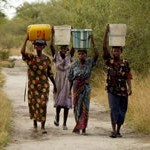
According to NACSO, the majority of Namibians depend directly on natural resources for their day to day needs. © David Sandison, NACSO
How can local communities best protect and manage their own natural resources? That was the topic of conversation presented at a networking session organised by NACSO, the Namibia Association for Community based natural resources management Support Organization, which Connect Africa recently attended in Namibia.
The three-day meeting explored new solutions to address the failures of top-down approaches to conservation. It is part of the wider Community based natural resources management (CBNRM) support programme which investigates options for empowering local communities.
A team from Zambia included the Zambian Wildlife Authority, the Conservation Farming Unit and Connect Africa, which specifically emphasised the need to include information and communication technologies (ICTs) in any approach to empower the community with local management information.
Lloyd Kabulwebulwe, Connect Africa’s country coordinator, said: “It’s a matter of integrating ICT use into natural resource management. Most communities in the rural areas we are talking about are cut off, with no access to electricity or mobile phones and information. Such facilities can improve the effectiveness of natural resource management in general,” he said.
He added that local communities must have direct control over use and benefits accrued from natural resources – wildlife and habitat – to value them and therefore better protect them in a sustainable manner.
“We can share our experiences in the field to bridge the digital divide, which can be adapted to improve communication in natural resource management,” said Kabulwebulwe. “This is a platform through which to link education, game management and agriculture, key areas in conservation,” he concluded.
NACSO was started in 1996, with a philosophy to harness the wide range of skills available in government and to share experiences with the non-governmental and other sectors. Objectives include advancing rural development and empowering communities through capacity building and good governance to help them determine their own destiny.
The meeting included field trips to conservation areas, where local institutions have been set up to manage resources by the government of Namibia. These provide a platform for experience-sharing among stakeholders with a special interest in improving the livelihood of rural communities. Issues discussed by the groups include improving rural democracy by creating locally managed areas with clear boundaries.
Sustainability strategies and extension approaches
Outcomes of the meeting included exploring the establishment of a permanent CBNRM approach which:
- Includes government, NGOs and the private sector.
- Recognises the role of integrated resources management.
- Harmonises inter- ministerial policies, legislation and approaches to empowering communities to manage their natural resources.
- Improves efficiency and cost – effectiveness of CBNRM training effort and recognises that local areas have different needs at different stages of development: emerging, developing and established.
- Maintains training databases and development of annual training plans.
For more information visit the NACSO website here.
